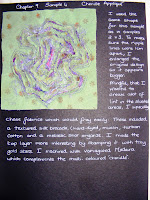 |
| Sample 4 Slashed Applique Worksheet (A4) |
 |
| Slashed Applique Close Up 14cm x 14cm |
 |
| Sample 5 Ripple Applique Worksheet (A4) |
 |
| Ripple Applique Close Up 14cm x 14cm |
sides of the top yellow linen, to reveal the collage of colours underneath. I actually accidentally burnt a patch of organza away when I was pressing the finished piece, but it was serendipitous as a piece of green muslin simply appeared beneath. It would be interesting to try this with a soldering tool!















